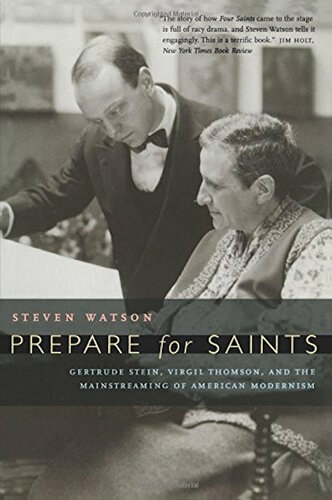
Prepare for Saints
Gertrude Stein, Virgil Thomson, and the Mainstreaming of American Modernism
کتاب های مرتبط
- اطلاعات
- نقد و بررسی
- دیدگاه کاربران
نقد و بررسی

January 4, 1999
Virtuoso literary journalist Watson's Strange Bedfellows: The First American Avant-Garde (1991) set the standard for books seeking to accessibly summarize complex literary and artistic movements, blending time lines, lexicons of period argot, unfamiliar photos and accounts from the newspapers of the day. Here, Watson applies the same formula to a definitive moment in Modernist history: the collaboration of Gertrude Stein and composer Virgil Thompson on the 1934 opera Four Saints in Three Acts, the first large-scale, homegrown avant-garde theatrical production to surface on the cultural radar (revived two years ago in Houston and New York by Robert Wilson). Coming a year after Brenda Wineapple's Sister Brother laid bare the finally explosive relationship between Gertrude and Leo Stein, Watson's book shows how the galaxy of talent that orbited around the Stein/Toklas household at 27 rue de Fleurus joined forces with a group of echt-Harvard tastemakers who saw a good thing and ran with it, mounting the incomparably lovely but plotless opera with an all-black cast, gracing it with innovative sets by the still under-appreciated Florine Stettheimer and promoting it with the sort of PR machine unknown in the art world at that time. Watson doesn't miss an angle on the story of how these forces came together and eventually took the show from its Hartford, Conn., premier to a smash Broadway run: Thompson's odyssey from small-town America to cosmopolitan composer; Stein's brilliant writing and imperious holding of court; the involvement of Philip Johnson and the fledgling Museum of Modern Art. Most refreshingly, Watson details the inseparability of African-American artists and culture from the opera, from the sexual stereotypes of the era and from modernism at large. (Feb.) FYI: Watson has also written, directed and coproduced the documentary Prepare for Saints: The Making of a Modern Opera, hosted by Jessye Norman, to be aired on PBS in February.

Starred review from January 1, 1999
Watson, author of The Harlem Renaissance (LJ 5/15/95) and Strange Bedfellows: The First American Avant-Garde (LJ 3/1/91), is obviously fascinated with the making of "the modern" in America's 1920s and 1930s. His new work is an involving study of the opera Four Saints in Three Acts, written by Gertrude Stein and Virgil Thomson. The work was both a revelation and a revolution: an all-black cast, an abstract text, an "American" sound, and sets unlike any seen before (made mostly of brightly colored cellophane). Watson sets the opera within the context of the modernist movement and its most fascinating players, ladling up history, dramatic analysis, and enough gossip to provoke some chortles. He also includes information on subsequent revivals of the work, and the lives and careers of those involved in the first, and most incredible, production. The chapter notes and bibliography are excellent sources of information. Recommended for all academic and larger public libraries. (Index not seen.)--Susan L. Peters, Emory Univ. Lib., Atlanta

February 1, 1999
Gertrude Stein and Virgil Thomson's revolutionary modern opera, "Four Saints in Three Acts," provides the jumping-off point for Watson's breezy, fascinating history of how modernist culture was transplanted to the U.S. in the 1920s and 1930s. Watson introduces all the major and some of the minor players involved: the Paris-based expatriates, the monied New York bohemians, and the tight circle of Harvard friends (among them, Lincoln Kirstein, Philip Johnson, and Chick Austin) who did everything they could to push modernism, even founding major museums in Hartford, Connecticut--where "Four Saints" was first produced--and New York (the Museum of Modern Art) to house the modernist masterworks. But Watson doesn't give himself nearly enough room to fully explore his topic. Important figures enter and exit with the hurried speed of people late for a train. In the end, it is hard not to wish Watson had focused more tightly on Thomson and Stein--their stories alone are fascinating--and saved the rest of his subject for another, more detailed book. ((Reviewed February 1, 1999))(Reprinted with permission of Booklist, copyright 1999, American Library Association.)

























دیدگاه کاربران